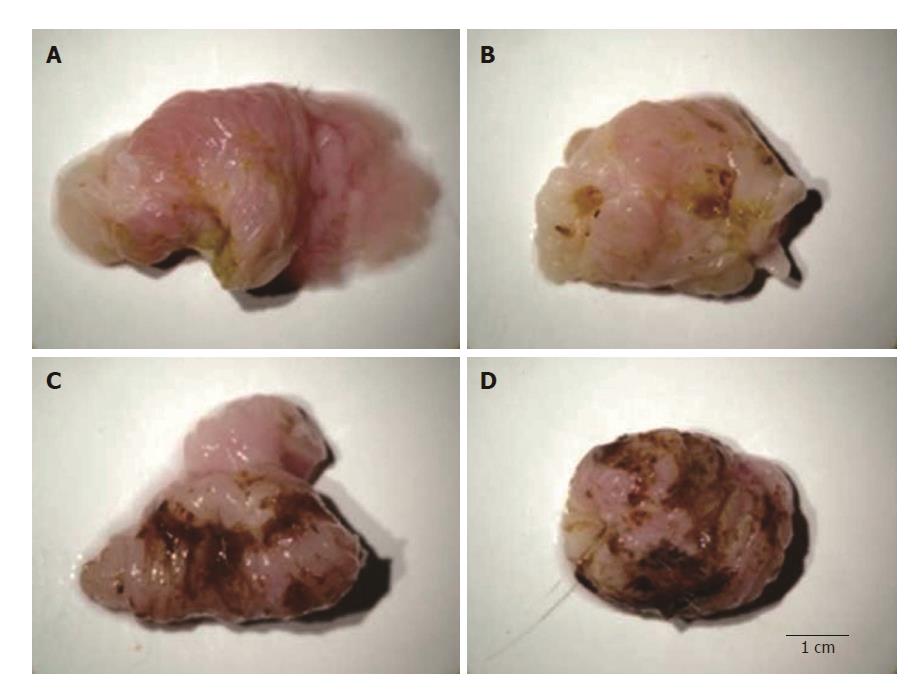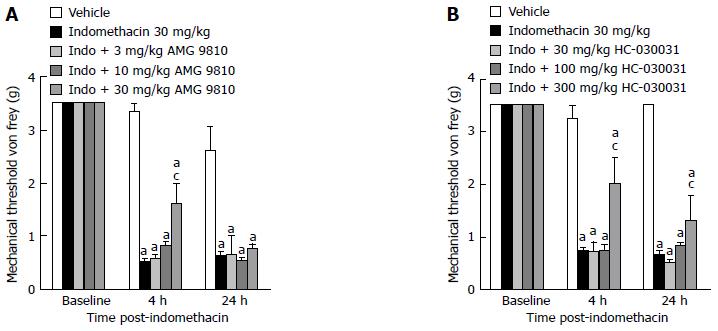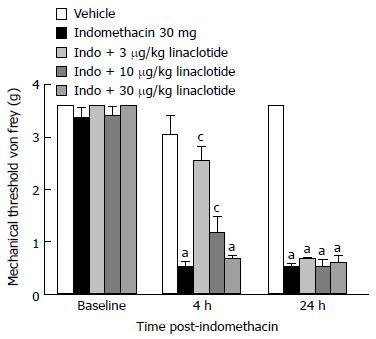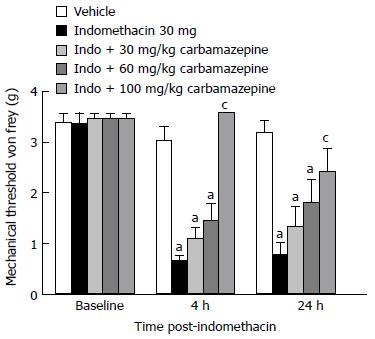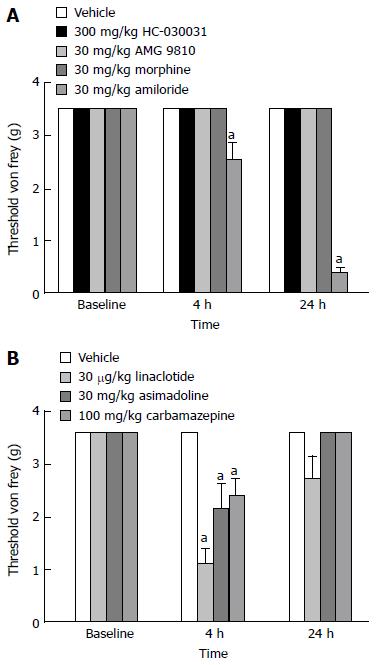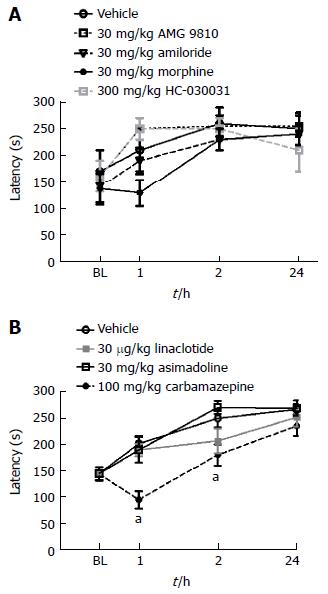Copyright
©The Author(s) 2017.
World J Gastroenterol. Sep 7, 2017; 23(33): 6065-6076
Published online Sep 7, 2017. doi: 10.3748/wjg.v23.i33.6065
Published online Sep 7, 2017. doi: 10.3748/wjg.v23.i33.6065
Figure 1 Representative digital photographs of stomachs dissected from mice orally dosed with vehicle (A) or 30 mg/kg indomethacin (B-D).
Stomachs were scored as follows: A: score 0 = no lesion (normal mucosa = vehicle); B: score 1 = light petechial; C: score 2 = diffuse bleeding or aphtha; and: score 3 = multiple aphtha.
Figure 2 Effect of opioid receptor agonism on gastric ulcer pain.
A: Dose-response and time course for the effect of a mu opioid receptor agonist on referred gastric ulcer pain. Morphine significantly attenuated referred gastric ulcer pain when dosed 10-30 mg/kg; B: Dose-response and time course for the effect of a selective kappa opioid receptor agonist on referred gastric ulcer pain. Asimadoline significantly attenuated referred gastric ulcer pain when dosed 10-30 mg/kg. All data are expressed as the mean ± SEM, where n = 8-10 mice/group. aP < 0.05 vs vehicle, cP < 0.05 vs indomethacin.
Figure 3 Effect of transient receptor potential channel blockade on gastric ulcer pain.
A: Dose-response and time course efficacy for selective TRPV1 channel blockade on referred gastric ulcer pain. AMG 9810 significantly attenuated referred gastric ulcer pain when dosed at 30 mg/kg; B: Dose-response and time course for the effect of selective TRPA1 channel blockade on referred gastric ulcer pain. HC-030031 significantly attenuated referred gastric ulcer pain when dosed at 300 mg/kg. All data are expressed as the mean SEM where n = 10 mice/group. aP < 0.05 vs vehicle, cP < 0.05 vs indomethacin.
Figure 4 Effect of acid-sensing ion channels channel blockade on gastric ulcer pain.
Dose-response and time course for the effect of non-selective ASIC channel blockade on referred gastric ulcer pain. Amiloride did not attenuate referred gastric ulcer pain at any of the doses tested. Data are expressed as the mean SEM where n = 10 mice/group. aP < 0.05 vs vehicle.
Figure 5 Effect of guanylate cyclase C agonism on gastric ulcer pain.
A: Dose-response and time course for the effect of linaclotide on referred gastric ulcer pain. Linaclotide significantly attenuated referred gastric ulcer pain when dosed 3-10 μg/kg. Data are expressed as the mean SEM where n = 9-10 mice/group. aP < 0.05 vs vehicle, cP < 0.05 vs indomethacin.
Figure 6 Effect of sodium channel blockade on gastric ulcer pain.
Dose-response and time course for the effect of carbamazepine on referred gastric ulcer pain. Carbamazepine significantly attenuate referred gastric ulcer pain when dosed at 100 mg/kg. Data are expressed as the mean ± SEM with 9-10 mice/group. aP < 0.05 vs vehicle, cP < 0.05 vs indomethacin.
Figure 7 Effect of compound administration on von Frey threshold in naïve mice.
A: The non-selective ASIC blocker amiloride significantly decreased abdominal threshold in mice 4 and 24-h post-administration when dosed at 30 mg/kg. B: Linaclotide, asimadoline and carbamazepine significantly decreased abdominal threshold in mice 4-h post-administration. Data are expressed as the mean ± SEM, where n = 9-10 mice/group. aP < 0.05 vs vehicle.
Figure 8 Effect of compound administration on rotarod performance.
A: AMG 9810, amiloride, morphine and HC-030031 did not produce any significant deficits in rotarod performance 1-24 h post-administration; B: Linaclotide and asimadoline were without effect while carbamazepine significantly altered rotarod performance 1 and 2-h post-administration, aP < 0.05. All data are expressed as the mean ± SEM, where n = 10 mice/group.
- Citation: Hummel M, Knappenberger T, Reilly M, Whiteside GT. Pharmacological evaluation of NSAID-induced gastropathy as a "Translatable" model of referred visceral hypersensitivity. World J Gastroenterol 2017; 23(33): 6065-6076
- URL: https://www.wjgnet.com/1007-9327/full/v23/i33/6065.htm
- DOI: https://dx.doi.org/10.3748/wjg.v23.i33.6065









